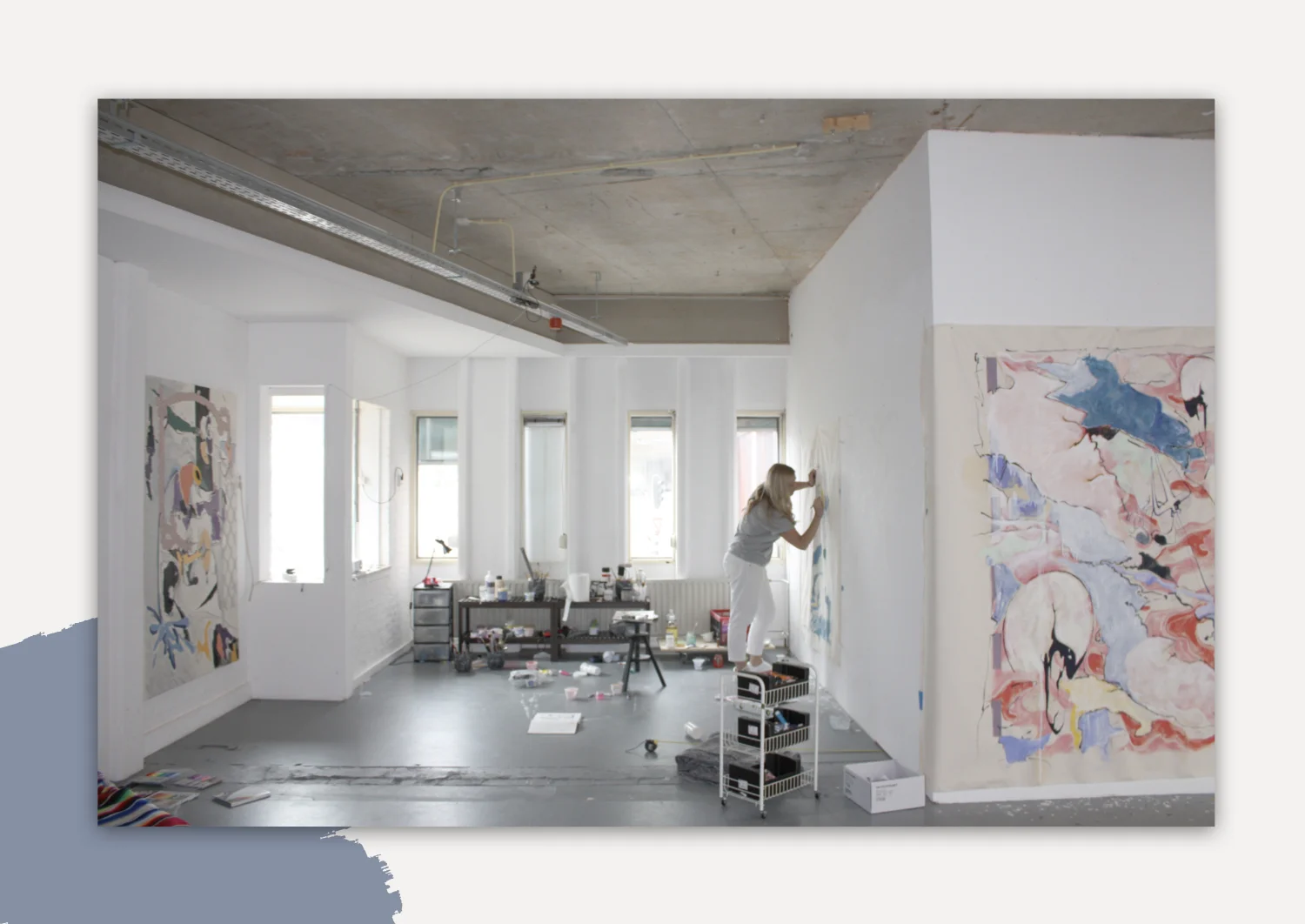How to Thrive on the Process: Interview with Artist Meg Forsyth
Meg Forsyth painting in her studio in the Netherlands
“Being an artist requires you to be vulnerable and avail yourself to criticism within a platform that is highly subjective. Especially when starting out, it is often necessary to step on stage and speak about your work whether through writing or giving talks, or explaining certain decisions you made to create your work. You have to ask for attention from gallerists, collectors, and peers which is more or less selling yourself in order to translate your product into currency. It can be challenging to be perpetually faced with a fear of rejection”
This is a snippet of wisdom from our interview below with Netherlands based, American artist, Meg Forsyth.
We found, in learning about Forsyth and her life as an artist, a strong similarity of her experience as an artist and that of women entrepreneurs: messy at times, vulnerable, and, ultimately, a journey that thrives on the process over the outcome.
Forsyth shares where she gets her inspiration, her personal artistic process, and more. This interview is dense with wisdom from an artist that has direct application to the life of an entrepreneur.
Gilbert: What inspires you?
Forsyth: I would say that my inspiration is not ever from a fixed source, but a multitude of sources. I am an incredibly curious person. I have found that I cannot seem to stop asking questions.
Presently, the Ancient Astronaut Theory is a critical source of inspiration. Ancient Astronaut Theory challenges cultural mythologies, theology, and mainstream science with the belief that our knowledge and technology may have come from ancient visitors who imparted advanced information and science with us that we didn't quite understand.
Embedded in my work is the belief that we, the human race, unconsciously and intuitively understand our history and evolution, and that we have access to higher perceptions of understanding one another and our relationship to the world we inhabit if we are willing to tap into it.
Gilbert: What is one of the hardest parts about being an artist?
Forsyth: I consider myself to be a bit of an introverted person, however, as an artist there is also a requirement to step out of the studio and participate with the public. Being an artist requires you to be vulnerable and avail yourself to criticism within a platform that is highly subjective. Especially when starting out, it is often necessary to step on stage and speak about your work whether through writing or giving talks, or explaining certain decisions you made to create your work. You have to ask for attention from gallerists, collectors, and peers which is more or less selling yourself in order to translate your product into currency. It can be challenging to be perpetually faced with a fear of rejection. All of this requires a relentless force of self-acceptance and perseverance. On the other hand, my experience so far has seen these moments of vulnerability as useful opportunities in providing powerful insights about where the work is currently, and where it might go next. I learn from the conversations, the questions, and challenges.
Gilbert: What impact in the world do you seek to make through your work?
Forsyth: I think this question is one of the hardest questions to answer, but perhaps the most important one for an artist. This is “the why” question. I believe in beauty and am driven to create beauty, to participate with beauty, and attach myself to its inner worlds. Beauty is so subjective and malleable. Culture, time, location, education, and many other unique components which make up a person’s habitus impact their perception on beauty. In addition to beauty, the act of being inspired by beauty or curious about the universe we live in is an act of participating in superconsciousness. I think in much the way a scientist is trying to understand the universe, the artist is doing the same. The difference lies in their methodology, where the scientist uses a systematic approach, and the artist handles it with an ethereal intelligence.
Gilbert: Do you have a specific process in how you create? How would you describe it?
Forsyth: Yes! Well, first I would say that I spend a lot of time researching. I don’t necessarily enter into research with the intention of using it in my paintings. I tend to get curious about a subject or range of subjects and a read about them, watch documentaries, look at images, go to shows, etc., etc. I carry around a lot of this information with me consciously and unconsciously.
I’m dedicated to drawing and make lots of automatic drawings. In order to generate automatic drawings, I enter into a state where I cut off my conscious thought by letting my hand guide itself through gestures and without a supplying a clear direction of where it ought to head. It’s a little bit like going into autopilot, but it feels more meaningful afterwards because you can visualize and appreciate the journey you have taken on paper. I do this in order to generate forms, which I see as a synthesis of my unconscious knowledge being brought to the surface.
From a series of automatic drawings, I select a few that I consider particularly successful in composition and form, or they lead me to deeper contemplation and curiosity. Sometimes I feel completely unsure about them, but I appreciate the tension.
From there I begin to introduce color either digitally in Photoshop, or with marker, pastel, oil sticks, or whatever I have lying around. This is a moment of astriction because I am never entirely sure where the drawing is headed and also understand that it will change again once I start working on the canvas. Only after I feel a general sense of composition and my intuition gives its blessing do I move to canvas.
Once on canvas, I become a bit more methodical because what was once a letter sized drawing grows 10 times its size. I use a projector or a scaled up drawing to get down the general placement of the original drawing. It’s tough because what was once an unconscious artistic act, slides into a draftsman application. Even while working as a draftsman, I attempt to access the freedom and power I held while working on the drawing. It feels like a push and pull and it isn’t always successful.
Once I do feel settled with an outcome, I begin applying paint. I apply the paint in different ways and try to re-attune myself with that free flowing behavior I had in the original drawing, allowing for slips, drips, and spills. Sometimes I work on the ground, sometimes I hang it on my studio wall. I like when the work ends up in a place with enough moments of control and slippage. It feels honest.
Gilbert: How do you think about / approach the business of being an artist? Challenges with that? Ways you’re thinking about that and/or doing things differently maybe than fellow artists?
Forsyth: I’m still finding my way around my artistic practice as a business. For the past ten years I have been working as a designer to “support my habit”. I think this is sometimes referred to as a “shadow artist” in the sense that I was working in a world surrounded by art, serving art, and in some ways performing a serviceable art. This method works out fine for some people and they truly love it, but during my graduate studies I realized that I couldn’t treat my art that way anymore and it had to stand in the spotlight. I think that concept is at the core of where my practice is headed now. It’s a shift from selling a service to selling a product.
Gilbert: Why is supporting artists so important and/or what is the power of art?
Forsyth: Well, I would like to say that it is important to support artists you feel aligned with. Artists have widely varying views and practices. They are motivated by so many different things. I have only outlined my own motivations here, but there are many others that have a completely different approach. I think it is fiercely important to find the artist you love and support them unwaveringly because you believe in what they are doing. You believe in their contribution to your life or the lives of others. Art has the power to touch people, to communicate emotions, to inspire curiosity, to rediscover the past, and to seek new frontiers. Art can be objects hung on a wall, or experiences carried with you. The important thing is that it has touched you in some way, and supporting the creators of those experiences enables them to carry on doing the work they love.

